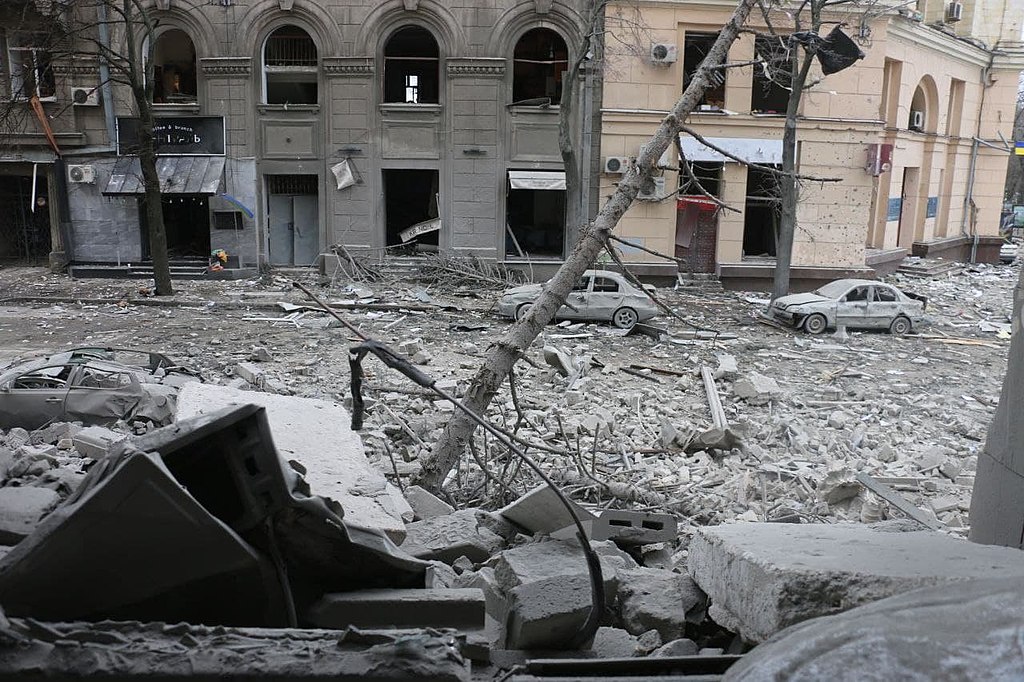
Photo: Kharkiv downtown street destroyed by Russian bombardment (March 1, 2022). Credit: Ministry of Internal Affairs of Ukraine (mvs.gov.ua) via Wikimedia Commons, licensed under CC 4.0 Attribution
Continuing with our coverage of the Russian invasion of Ukraine, we turn now to Kharkiv, the country’s second largest city, which was decimated by recent Russian air attacks. We spoke to a woman who fled Kharkiv – not this year, but during the Second World War – and who has been forced to watch her home city destroyed for the second time. On March 14, KPFA reporter Jehlen Herman interviewed Yelena Shuyer, who spoke in Russian as translated by her granddaughter Maria Lipkina, about her experience.
Yelena Shuyer was born in Kharkiv, Ukraine. She now lives in San Francisco, where she and her granddaughter Maria Lipkina are watching the Russian invasion of Ukraine unfold remotely. Millions of Ukrainians have fled the country – like Yelena herself did, decades ago, during another war.
Yelena was just three years old when World War II started and forced her family to flee Kharkiv, Ukraine for Kazakhstan. She was young, but that journey stayed with her.
YS: It’s my, my first remember [sic]…
ML: My first memory at three years old… I remember fleeing Kharkiv. I don’t remember what Kharkiv was like at that time, but I remember fleeing and we went on a train that was a train for livestock… We were in this train and I remember at certain points there was bombing from overhead and we would have to run to the bushes alongside the railroad to hide during the journey,
The family eventually returned to Kharkiv after the end of the war, but to a city that was devastated.
ML: I remember coming back and riding in the back of an open pickup truck and seeing all of the buildings in Kharkiv. And there wasn’t a single building that was whole. Everything was in ruins. And there were big holes in the walls where the windows had been. And that’s what I remember from Kharkiv.
Yelena pulls up a Youtube video on her iPad and hands it to me. It’s a compilation of videos taken in Kharkiv over the past weeks when Russian airplanes bombed the city. The video shows crumbling buildings with billowing flames. Huge chunks of apartment buildings are just… gone.
ML: She says now it’s the same thing that I have to see it again.
The person who sent Yelena that Youtube video is her best friend, Sveta, short for Svetlana. But while Yelena lives in the United States, Sveta is still there in Kharkiv. Despite the ongoing war, Yelena and Sveta talk on the phone every day, twice a day.
ML: She says, I still talk to my friend every day in the morning and in the evening. And, sometimes I can hear the bombs… She lives on the fifth floor and in her building, there’s barely anyone left, but she just lives on the fifth floor alone. There’s no one at all left on the fourth floor.
Most of the neighbors have left, but Yelena says that’s not an option for Sveta because her health isn’t strong enough.
Being across the globe, Yelena can only experience what’s happening in Ukraine remotely – through online videos or these phone calls with Sveta. She worries that one day Sveta might lose phone or internet connection or that worse, they’ll lose each other. Like so many other people who have been caught up in the collateral damage of war.
ML: I still can’t believe that Russia, which is a country. where there isn’t a single family that wasn’t affected by World War Two, where there isn’t a family that didn’t lose someone or suffer in some way, would start something like this. And with Ukraine, where the people are like brothers and sisters, where it’s the same.
But among her memories, Yelena also has another one of Kharkiv that she hopes she’ll also get to see again: that of the city being rebuilt after World War II and coming back to life.
ML: Eventually people were restoring the city. And when they would dig through the ruins, they would find a little square or a park. And they started to slowly rebuild one house or one park at a time. And that’s how they rebuilt the city.
—
By Jehlen Herdman
First aired on UpFront on March 29, 2022

